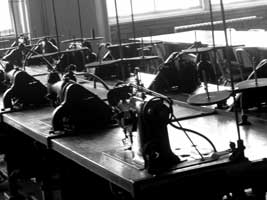| 
The
Height of Fashion Education
by
Rob Luchow
Imagine
walking in to school and discovering that your principal has
been replaced by fashion designer Kenneth Cole. That has happened
at the High School of Fashion Industries—twice.
Located
at 225 West 24th Street, the High School of Fashion Industries
boasts itself as the premiere (and only) public school in New
York City offering its students curriculum based around the
fashion world. Originally started in the early 1920s as Needles
and Trade High School teaching students to be factory workers,
today the school remains in the same building and still houses
some of the old Singer sewing machines.
Yet
the curriculum has changed greatly as students now select one
of three offered majors—fashion design, illustration and graphics,
and business and marketing. Each day, students take one or
two classes in that major on top of regular classes like math
and social studies.
“A
common misconception is that our kids sew all day,” said Olivia
Severs, Director of Admissions and an English teacher at the
school.
While
sewing does occur in the classroom, it involves much more than
simple embroidering. Students who choose the fashion design
major can specialize in pattern making, draping and bodywear,
and intimate apparel. Students begin by learning the basics
of design and advance to creating their own original garments
from scratch.
For
those students not interested in the hands-on aspect of designing,
the school offers classes in business and marketing. Here,
students engage in the economic side of the industry learning
computer skills, record keeping, and merchandising tactics.
One class entitled “Window Display” teaches students how to
entice the customer while managing the display cases in and
outside of the building.
The
school strengthens the students’ understanding of the fashion
industry by offering unique opportunities to immerse them in
the trade. For one, the school store is entirely run by the
students. This includes the selection, advertising and sale
of the products. In past years, students have sold everything
from jewelry to teddy bears. Also unique is the school boutique
wear student-designed garments are sold however only students
and faculty can purchase them. Outside of the school, students
have access to internships that have been made available by
numerous fashion companies’ donations.
However,
the ultimate symbol of the students’ achievement occurs with
the annual spring fashion show. The show runs for three nights
with one show open to the public and one for members of the
fashion industry. Involving mostly juniors and seniors, the
runway show event displays the many talents of the students.
“They
create the concept, design the clothes, model them, do make-up,
set design and handle the advertising,” said Severs, who herself
worked for several fashion magazines before teaching.
When
talking to Severs, she stressed the importance that this school
achieves beyond its involvement with fashion and business.
The curriculum is intended to provide a creative outlook and
classes provide a different view of subject material, such
as Math classes teaching dimensions and proportions. In Severs’ English
class, she teaches F. Scott Fitzgerald’s The Great Gatsby by
incorporating art and culture of the 1920’s. This method, according
to Sever, shows that “what is important is not just the material
but the time in which it was written. Students learn about
trends in literature, art and fashion.”
Severs
believes the success of the school has been the “phenomenal
teachers” and “ a school that has made a commitment to keeping
good teachers.” The school offers an extensive tutoring system
where teachers make themselves available before and after school
for help. Severs said that she often sees teachers take lunches
in their rooms with their doors open.
However,
to prove success, the school lays claim to an impressive statistic:
the school is tied for third place for the highest Regents
exam scores. For students seeking scholarship money, 164 students
in the graduating class of 2003 were offered money totaling
over $4 million and almost half of that money was accepted.
Admission
to the High School of Fashion Industries is highly selective.
Students must complete an application to the Board of Education,
take the school’s exam that includes an art aptitude test,
and submit a portfolio. Severs said however that students are
not expected to have formal training in the arts and many students
apply who have little drawing abilities. For prospective students,
the school offers pamphlets in most junior high schools and
several open house events during the year that include a mock
school day with 15-minute classes.
For
the future of the High School for Fashion Industries, Severs
hopes for things to remain as good as they are. She foresees
changes occurring alongside technology, but mostly she wants
to “see us grow along with the trade.”#
For
more information on the High School for Fashion Industries,
visit their website at www.fashionhighschool.net.

Education
Update, Inc., P.O. Box 1588, New York, NY 10159.
Tel: (212) 477-5600. Fax: (212) 477-5893. Email: ednews1@aol.com.
All material is copyrighted and may not be printed without express consent of
the publisher. © 2003.
|
